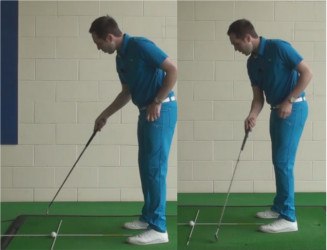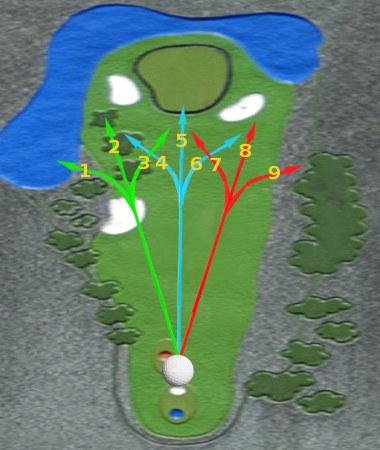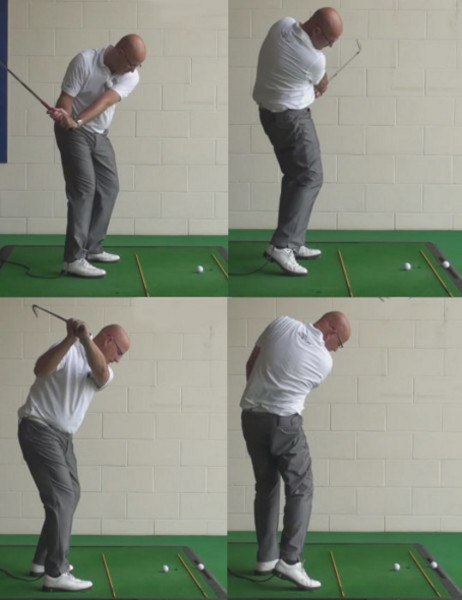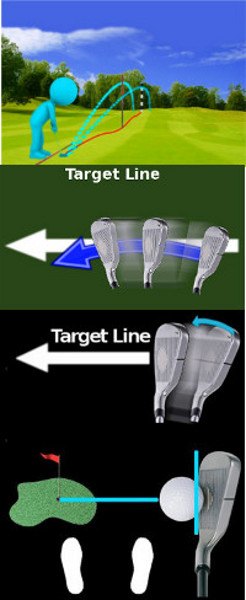
Shaping the golf ball can be a huge advantage when playing a round of golf.
Shaping the golf ball is very important when you would like to position your drive off the tee so that you hit the best side of the fairway to make the next shot much easier. Also, shaping iron shots when approaching the green where a flag is tucked to the right or the left of the green is a must when looking at shooting better scores. The last reason to shape the ball on demand would be if there is trouble in the way or you need to shape it around something. For example, if you have hit your golf ball off the fairway and there is no direct line to the flag or green, shaping the golf ball can rescue you out of trouble.
The most common controlled ball flights are the fade and draw shots. A fade is a shot for a right handed golfer that starts to the left of the target and curves to the right so that it finishes on target (left handed - a fade starts right of the target and curves to the left, back on target). A draw is a shot for a right handed golfer that starts to the right of the target and curves to the left so that it finishes on target (left handed - a draw starts left of the target and curves to the right so that it finishes on target).
Fault - A player may struggle to shape the golf ball on demand, and therefore finds it difficult to get the golf ball closer to the hole or around obstacles.

Fix - This drill is perfect to help you shape the golf ball in both directions on demand. The most common shot shapes players want to hit are draws and fades. This drill will help you hit both. First imagine you have a circle around the golf ball on the ground with about a two feet radius. Use the circle to picture a clock face with numbers around the circle with the 12 o'clock number pointing towards the target and the 3 o'clock pointing away from you. A draw is a shot for a right handed golfer that starts to the right of the target and curves to the left so that it finishes on the target. To hit a draw shot, the club needs to travel through the ball from the inside and exit the ball from the outside with the club face open to the target but closed to the path. If you use the clock face as a guide for the golf club's swing path to hit the draw, the club needs to swing from 7 o'clock to 1 o'clock and the club face needs to be aiming at 12:30 on the clock face. This will make the ball start to the right of the target and curve back to the target because of the swing path.
To hit a fade, use the same clock face, however this time the swing path needs to be from outside to inside and the face closed to the target yet open to the path.
Use the clock face to enter the ball from the outside, so the 5 o'clock position and exit the ball on the inside which is the 11 o'clock position whilst aiming the club face at 11:30.

How Do I Shape the Golf Ball on Demand?
To most golfers, the ability to shape shots on demand seems like an advanced skill. And, in fact, it is. It is difficult to get the ball to curve the way you want it to curve time after time, especially if you are trying to move back and forth between fades and draws depending on the shot at hand. This is a hard game, and shaping your shots with precision is something that is usually only executed by talented, experienced players.
But here's the problem – when amateur golfers think that this skill is over their heads, they wind up not even trying to learn it. How are you going to get better at this game if you simply think something is too hard to even try? You won't, of course. If you chalk up things like shaping your shots to skills which should be left for better golfers, your game is always going to be stuck in neutral.
We would like to suggest a different plan. Rather than thinking you aren't good enough to make this happen, we think you should give it a try. Are you immediately going to be able to head out to the course and produce a variety of draws and fades on demand? No – of course not. This is still a big challenge, and you are going to have plenty of struggles along the way. But those struggles are simply proof that you are working your way toward something greater in your game. Only those who are willing to step out of their comfort zone to try something new and difficult will be rewarded with improved play in the end.
In this article, we are going to discuss some of the steps you need to take in order to improve your game in the area of shaping shots. We are not saying that you will be a master at ball flight control when you are done with this article – you almost certainly won't be. You can, however, take a step in the right direction and plant the seeds for further growth in the future. You should have a clear understanding of this topic by the time you are finished with this article, and understanding is the first step in the process of adding shot shaping to your own game.
While you work on this skill, it is perfectly acceptable to 'keep it in the bag' while just using your normal shots on the course. If you try to shape shots on the course shortly after learning this skill on the range, you will likely get discouraged and give it up. After all, you shouldn't expect much in the way of results for some time. For now, leave this as a project to work on during practice while sticking with your standard shots on the range. Only when you can produce consistent results on the range should you think about taking this process to the next level.
All of the content below is based on a right-handed golfer. If you happen to play left handed, please take a moment to reverse the directions as necessary.

Finding Your Starting Point
In golf, everything is relative. In other words, all of your efforts to shape the golf ball are going to be impacted by your 'standard' golf swing and ball flight. All golfers start from a slightly different point, as no two swings are exactly alike. The advice we provide in this article is going to be based on adjustments you can make from your baseline. Of course, in order to adjust effectively, you have to know what your baseline is in the first place.
The starting point for all of your shot shaping efforts is going to be the ball flight you use for a standard shot. What happens to the ball when you just make a swing, with no effort to shape it in any particular direction? The ball flight that results from such a swing should be considered your standard shot. Whether that means the ball turns left a little, or right a lot, or takes any other flight, that ball flight is yours and you should own it. Going forward, you will be learning to shape shots based off of that starting point.
It is common for golfers to fight against their standard ball flight. We would suggest that you don't make this mistake. For example, a golfer who naturally hits a slight fade may want to change his or her swing in order to primarily play a draw. This is making the game harder than it needs to be. If you have a natural ball flight, you will be best served to stick with it – even if that flight is not what you would consider to be ideal. Trust it, learn to make the most of it, and create other shots from there. In the long run, and especially under pressure, you will be happy that you stuck with your natural shot shape.
The only way to accurately determine your standard ball flight is to play golf. By hitting more and more shots – both on the course and on the range – you will gradually uncover your default ball flight. Since no golfer is perfectly consistent, you should expect to see some other shapes sprinkled in along the way, even if you are trying to hit the same kind of shot time after time. For instance, if you hit 10 shots in a row with the same club on the range, you might find that eight of them fade to the right while two draw to the left. When that happens, you can safely assume that your standard flight is a fade, even if there were a couple draws along the way. You shouldn't wait until your ball takes the same flight every single time to make a decision on this point, because that day is not coming. All golfers, even professionals, will hit some surprising shots from time to time.
Once you are confident that you have identified your standard shot shape, you can move on to learning new shots. The rest of this article will be dedicated to helping you adjust from your stock shot to a create a few other useful ball flights.

Going the Other Way
Since no golfer can reliably hit the ball in a straight line, it is a safe bet that your standard shot is either a draw or a fade. With that in mind, the first shot shaping skill you will want to learn is how to turn the ball in the other direction. For a player who naturally hits a fade, turning the ball over to the left can seem like an impossible task. Just the same, a player with a natural draw may have an extremely tough time fading the ball in toward the target. If you can get over this hurdle and learn how to go opposite of your standard shape, you will be well on your way to improved play.
Below, we have provided tips for each of the two categories of golfers – those with a draw, and those with a fade.
- Learning how to hit a fade. If you hit a natural draw, there are a few changes which will need to be made if you are going to impart fade spin on the ball at impact. The first change you should make is to open your stance slightly to the target line. You need to swing across the ball from outside-in if you are going to produce a fade, and opening your stance will make this easier. Next, consider turning your left hand into a slightly weaker position at address. That means turning your left hand to the left on the grip. This will take some of the hand action out of the bottom of your swing, holding the face open and helping the ball to fade. Finally, you are going to move the ball slightly forward in your stance. With a forward ball position, the club will be more likely to catch the ball on the way back in toward your body, which is perfect. However, when you do use a forward ball position, you need to make sure to resist the temptation to slide up toward the ball in the downswing. Focus your downswing on rotation and avoid the dreaded slide which will knock you off balance. In the end, you should be able to work toward a fade successfully by blending an open stance, a weaker grip, and a forward ball position.
- Learning how to hit a draw. It should be no surprise that the points in this section are going to be largely opposite the points in the previous section. Rather than opening your stance, you are going to close it down to promote an inside-out hit. Again here, you don't want to make this adjustment too dramatically, or you could wind up with a hook rather than a draw. Also, you are going to turn your left hand into a stronger position by rotating it slightly to the right. Finally, move the ball back by a couple inches when taking your stance. Along with these changes, you are going to have to allow yourself to release the club freely at the bottom of the swing. That doesn't mean you are going to literally let go of the club – it just means you are going to allow the right hand to fire through the ball, rotating the club face and creating the right-to-left spin that you need.
We will be honest here – the results at the start of this process are likely to be ugly. At first, you may struggle to hit anything that looks like what you had in mind at the start of the swing. There will probably be some duck hooks and big slices, and it may be that you struggle to create anything other than your standard shot. Habits die hard in life, and that is especially true in golf.
The only golfers who manage to learn how to work the ball effectively are those who are willing to take on the challenge. Instead of running the other direction when you start to struggle, you need to embrace the difficulty of this sport and dig in. If you are willing to see this through from start to finish, amazing things will be possible in your game.

Hitting a Lower Ball
Many golfers think about shaping their shots only in terms of left and right. This narrow view of the topic overlooks an important skill on the links – being able to adjust the height of your shots on demand. Specifically, the ability to hit the ball lower than usual on command can help you get out of many difficult spots. Whether you are hitting into the wind or just want to play a controlled shot that doesn't have as much time to stray off line, hitting the ball low is a valuable skill.
Do you know how to hit the ball low intentionally? If not, the following points should help.
- Move the ball back in your stance. This is the adjustment that you expected to see on this list. When you move the ball back, you are going to make it easier to hit down through impact, which is a key to this shot. Also, the lowered launch angle that you will receive by moving the ball back is going to keep the shot down, even if there is some significant backspin created. You don't want the ball all the way back by your right foot, but it should be at least to the middle of your stance, if not slightly farther back.
- Swing softer. You might not have seen this one coming. In addition to moving the ball back, you also want to make an effort to use a softer swing. By swinging softer, you are going to reduce the amount of backspin that is produced, which will help you to keep the ball down. A soft swing is also easier to control than a hard swing, and keeping the ball down is all about staying in control. Since you will be both swinging soft and playing the ball back in your stance, you will likely need to use at least one extra club to cover the distance at hand.
- Choke down on the grip. One of the best things you can do to move your ball flight down is to choke down slightly on the grip at address. This is going to shorten the length of the club – not literally, but effectively – and it will make the ball more likely to come out on a low path. You will gain control thanks to this adjustment as well, and we already have established that control is a very good thing in this case. Feel free to experiment with choking down on the grip by various amounts to see how your ball flight is impacted.
- Stay on your left side. During the swing, make it a point to keep your center of gravity at least in the middle of your stance, if not slightly leaning toward the left. Then, as you swing down, be sure to get your weight onto your left side effectively. You don't want to be hanging back while trying to hit this shot, or it will inevitably get higher up into the air than you would like. Make a controlled, compact backswing while staying over the ball and you should be in good shape for the right kind of strike.
The good news with regard to learning a lower shot is this – you can expect to make progress on this kind of shot much faster than you will progress with the other ball flights. It is relatively easy to learn how to hit the ball lower, since you really aren't changing anything fundamental about your swing. All of the adjustments are simple in nature, and they should be pretty easy for the average golfer to execute. Even after just one or two practice sessions, you may have enough confidence to hit lower shots in an upcoming round.

Common Problems
You are going to run into problems along the way while trying to develop this skill. We aren't trying to be negative here – that is just a fact of the matter. To help you work through those issues as quickly and successfully as possible, we have provided some tips below. When you find yourself stuck during this progress, it may be that one of these tips can get you back on the right path.
- Making poor contact. It is common to struggle with poor contact when trying to work the ball. By making changes in your swing, everything is going to feel a little uncomfortable, and your natural ability to find the ball with the sweet spot may disappear for a while. To get it back, focus on the basics. Keep your head down through the shot, watch the ball carefully, and avoid swinging too hard. You really need to key on the simple things here in order to improve your quality of contact when shaping shots. As you gain experience, you will get more and more comfortable with these new swings, and the ball will find the sweet spot more frequently as a result.
- Too much shape. In an effort to turn your fade into a draw, for example, you might find that you wind up with way too much draw for an effective shot. When that happens, you need to dial back your adjustments until you land on a happy medium. You should be encouraged that you were at least able to create a shot that turned in the opposite direction as your standard shot. That is a big hurdle, and one that many golfers never manage to clear. From here, all you have to do is work on the details until you are pleased with the ball flight pattern you have created. Dialing it in will take some time, but you can feel good knowing that you are on the right track.
- Indecision. This is an advanced problem, as it will occur after you have learned how to hit these various types of shots. Once on the course and ready to try out your new ball flights, you may find that you have a hard time making a clear decision. When should you use one of your new flights? When should you stick with your standard shot? It can be hard to make these calls on the fly. As a general rule of thumb, you always want to hit your stock shot whenever it makes sense. In other words, if your basic ball flight is a suitable choice for the shot at hand, go with it and don't look back. Only when you actually need to hit another type of shot in order to make your way to the target should you do so. Keeping this plan in mind will help tremendously. Assume you are going to hit your standard shot in most situations and only move away to your other options as needed.
Learning how to shape the golf ball on demand could be one of the best things you do for your golf game. Yes, it is going to take time, and yes, it will be challenging – but there is a significant reward when all is said and done. Once you know how to shape the ball, you will be able to pull out different shots at just the right time, while sticking with your standard shot in most circumstances. That means you will be able to optimize your path around the course, hopefully avoiding obstacles and putting your ball in great positions. We hope the advice offered in this article will help you in your pursuit of a collection of new and useful shot shapes. Good luck and have fun!






